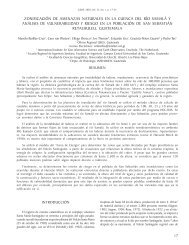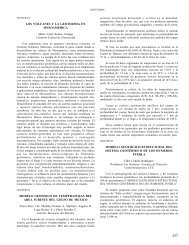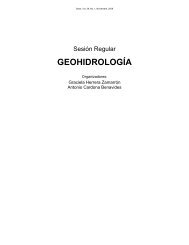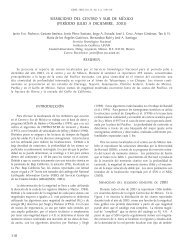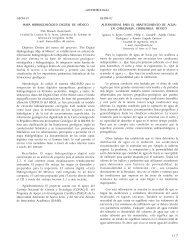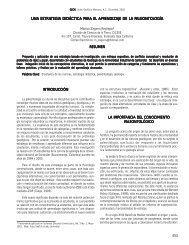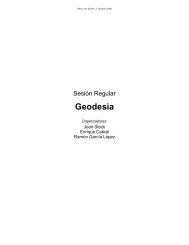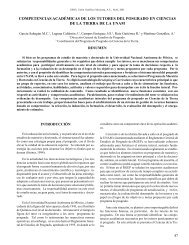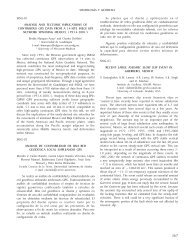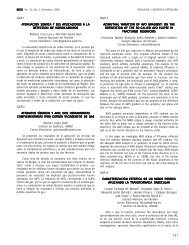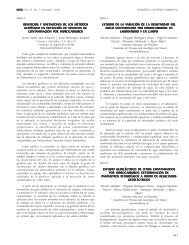VARIABILIDAD CLIMÁTICA DEL CUATERNARIO EN REGISTROSCONTINENTALES Y MARINOSGeos, Vol. 31, No. 1, Noviembre, 2011SE05-8RECONSTRUCCIÓN PALEOAMBIENTAL DEL LAGO DE Z<strong>AC</strong>APU,MICHO<strong>AC</strong>ÁN A TRAVÉS DE UN ANÁLISIS MULTIELEMENTALChang Martínez Laura Alfonsina 1 , Roy Priyadarsi 2 , Garduño MonroyVíctor Hugo 3 , Domínguez Vázquez Gabriela 1 y Isra<strong>de</strong> Alcántara Isabel 31 Facultad <strong>de</strong> Biología, UMSNH2 Instituto <strong>de</strong> Geología, UNAM3 Instituto <strong>de</strong> Investigaciones Metalúrgicas, UMSNHchangml07@gmail.comZacapu es un sistema lacustre que se encuentra en una <strong>de</strong> las cuencashidrológicas más importantes <strong>de</strong>l país, pertenece a la región hidrográficaLerma – Santiago, <strong>de</strong>ntro <strong>de</strong> la subcuenca Lerma –Chápala (CNA, 1998),en el estado <strong>de</strong> Michoacán. Este sistema lacustre está localizado <strong>de</strong>ntro <strong>de</strong>lCinturón Volcánico Mexicano (CVM). El objetivo <strong>de</strong> este trabajo es reconstruirlos cambios ambientales durante el Pleistoceno tardío-Holoceno a través <strong>de</strong> unestudio utilizando la geoquímica como indicador principal, comparándolo conla susceptibilidad magnética y el contenido <strong>de</strong> carbono orgánico e inorgánicototales. Se realizaron tres trincheras, la más antigua es “Trinchera 3”, con unaprofundidad <strong>de</strong> 2.20 m, “La Noria” con 3.20 m <strong>de</strong> profundidad y “El Inverna<strong>de</strong>ro”con 2.20m <strong>de</strong> profundidad. Se realizó el análisis <strong>de</strong> la susceptibilidad magnética<strong>de</strong> los estratos muestreados con el equipo Bartington Magnetic susceptibilitymeter y un sensor MS2E. Para la concentración <strong>de</strong> elementos mayores y trazas,se usó el equipo <strong>de</strong> Fluorescencia <strong>de</strong> rayos XNitton XL3t <strong>de</strong> marca ThermoFisher Scientific.En cada una <strong>de</strong> las trincheras se obtuvo incrementos coinci<strong>de</strong>ntes con lasusceptibilidad magnética y/o los carbonatos. En estas trincheras se observoque los carbonatos que se encontraron son pertenecientes a elementosclásticos antigénicos. Los elementos encontrados se pudieron agrupar enelementos <strong>de</strong> proce<strong>de</strong>ncia máficos y félsicos y elementos solubles. Loselementos máficos se consi<strong>de</strong>raron <strong>de</strong>ntro <strong>de</strong> aporte pluvial ya que son lospertenecientes a la zona como los basaltos <strong>de</strong> an<strong>de</strong>sita y así mostraban unclima más húmedo. Luego los elementos félsicos que se encontraban fuera <strong>de</strong> lacuenca mostraron aporte eólico y mayor sequía y al final los elementos solublesque en este estudio se comportaban <strong>de</strong> manera semejante a los clastos máficosy en otras ocasiones representaban a la cantidad <strong>de</strong> elementos biogénicos.SE05-9CLIMATIC VARIABILITY OVER THE LAST MILLENNIUM IN WESTERNMEXICO AS DEDUCED FROM THE CLIMATE PROXY DATA (C<strong>AC</strong>O3)RECORDED IN SEDIMENTS FROM LAKE CHAPALA (FIRST RESULTS)Zarate Del Valle Pedro F. 1 y Ramírez Sánchez Hermes Ulises 21 Departamento <strong>de</strong> Química, UDG2 Departamento <strong>de</strong> Física, UDGzavp.pvaz@gmail.comIn tectonic Lake Chapala (LCH) it is not possible to establish an absolute timescale by traditional methods (cf. 14C) due to the presence of old carbon (>50.000 y BP, 14C) that has doped the sediment, as a result, its radiometric agewas increased by one or<strong>de</strong>r of magnitu<strong>de</strong>, a fact that for Quaternary researchis a large variation. An approach to chronological calibration of the sedimentarycolumn of LCH has been ma<strong>de</strong> by the mean linear sedimentation rate (2mmy-1) which has been established for the last 200 years (~30 cm <strong>de</strong>pth) throughthe activity of the radioisotope of 210Pb after the Constant Initial Concentrationmo<strong>de</strong>l age. In turn, the magnetic properties of sediments allows us to establish awi<strong>de</strong>r relative time scale for the last millennium (~180 cm <strong>de</strong>pth). To do this, in thesedimentary column historic point phenomenon such as volcanic eruptions, havebeen i<strong>de</strong>ntified in places by the presence of high magnetic susceptibility values(>2000 x 10-9 m3 kg-1) and minerals like titanomagnetite, pyrite and feldspar.Variations in the calcite content (CA) recor<strong>de</strong>d in the sediment of a lake areclimate proxy useful to i<strong>de</strong>ntify the cyclic events of rain and drought (CRD) inthat region. It is well known that the precipitation of CA is higher during droughtperiods when temperature, evaporation and carbonate ion concentration (CI)increase, which allows greater precipitation of CA whereas during wet (rainy)periods the reverse process occurs and is characterized by a <strong>de</strong>crease in the CAprecipitation in sediments. The chronological CRD record as <strong>de</strong>duced by the CAmay be altered due to local phenomenon such as volcanic eruptions and theirashes and when settle, alter physical and chemical properties of sediment-waterinterface of the lake. The variations of CA measured in the sediment of LakeChapala by the Loss On Ignition method with a resolution of 2 cm, have provedto be a useful climate proxy to i<strong>de</strong>ntify regional and local phenomena. As aregional phenomena, the last millennium CRD characterized western Mexicoand have been registered in LCH and in other lakes like Zirahuen, Cuitzeo,Patzcuaro, in the lava-dammed lake Laguna <strong>de</strong> Juanacatlan, in the crater-lakeSanta Maria <strong>de</strong>l Oro and in regions as far north as the Corn Belt (USA). TheCA irregular variation is interpreted as the record of a local phenomenon link tohistoric volcanic eruptions.As preliminary results the last North-American drought of the Medieval ClimateAnomaly (1360-1382) as well as the mo<strong>de</strong>rn droughts of centuries XIX(1889-1896) and XX (1931-1940, 1950-1957, 1989-1991, 1999-2003), thehistoric eruptions of Colima Volcano (1576-1623, 1770-1771, 1818, 1913) andperhaps the activity of Jorullo Volcano (1759) have been i<strong>de</strong>ntified in LCHshallow sediments (~180 cm <strong>de</strong>pth) by applying the CaCO3 record as a climateproxy.SE05-10REGISTRO PALEOAMBIENTAL DEL HOLOCENOEN EL LAGO DE CUITZEO, CENTRO DE MÉXICOIsra<strong>de</strong> Alcántara Isabel 1 , Domínguez Vázquez Gabriela 2 , Bischoff James 3 , LozanoGarcía María <strong>de</strong>l Socorro 4 , Ortega Guerrero Beatríz 5 y Garduño Monroy Víctor Hugo 11 Instituto <strong>de</strong> Investigaciones Metalúrgicas, UMSNH2 Facultad <strong>de</strong> Biología, UMSNH3 USGS4 Instituto <strong>de</strong> Geología, UNAM5 Instituto <strong>de</strong> Geofísica, UNAMisaisra<strong>de</strong>@gmail.comEl lago <strong>de</strong> Cuitzeo se integra a una ca<strong>de</strong>na <strong>de</strong> lagos orientados E-O <strong>de</strong>ntro <strong>de</strong>lgraben <strong>de</strong> Chapala-Acambay. Cuitzeo es una región <strong>de</strong> importancia climática yaque conforma una zona <strong>de</strong> transición entre el clima neártico y neotropical. Susbajos niveles lacustres (prof media 50 cm), lo convierten en un lago <strong>de</strong> interéspara estudios paleoclimáticos y paleoambientales dada su alta sensibilidad alos cambios a los largo <strong>de</strong>l tiempo. Se observa a nivel histórico que <strong>de</strong>spués<strong>de</strong> periodos <strong>de</strong>l Niño se ha producido la <strong>de</strong>secación <strong>de</strong>l vaso Oeste. El sectorcentro y Este mantiene más constante su tirante <strong>de</strong> agua.Presentamos los resultados <strong>de</strong>l análisis <strong>de</strong> diatomeas, geoquímico y polínico<strong>de</strong> un núcleo <strong>de</strong> 2m. extraído <strong>de</strong>l sector centro oriente <strong>de</strong>l lago. Litológicamenteestá caracterizado por una base limo arenosa que pasa a una sucesión <strong>de</strong> limosy arcillas limosas en la zona central. La cima <strong>de</strong>l núcleo rica en gasterópodos. Lacronología <strong>de</strong> este registro paleoambiental se basa en 7 fechamientos <strong>de</strong> AMSque cubren los últimos 10,400 años. Un alta tasa <strong>de</strong> sedimentación se observaen el Holoceno temprano, esta se reduce gran<strong>de</strong>mente en el Holoceno medio,volviendo a aumentar 1000 años aP. El análisis polínico <strong>de</strong> Cuitzeo muestracambios importantes en la vegetación. La transición Pleistoceno-Holoceno, lavegetación estaba dominada por un matorral xerófilo, dominado por gramíneasy compuestas, condiciones similares han sido reportadas en otras cuencas <strong>de</strong>lCentro <strong>de</strong> México. Al final <strong>de</strong>l Holoceno temprano (6744 aP) y durante el periodoCálido Medieval (909 aP) se registran cortos incrementos <strong>de</strong> precipitación y unmejoramiento <strong>de</strong>l clima hacia condiciones más cálidas. Estos cambios estánsiendo sugeridos por los aumentos en la señal <strong>de</strong> carbono orgánico Total (COT),se observa un aumento <strong>de</strong> los bosques <strong>de</strong> pino-encino aunado a un importanteincremento en el bosque tropical asi como la presencia <strong>de</strong> Stephanodiscus aff.minutulus y Aulacosira granulata var. angustissima. Un incremento <strong>de</strong> la aridézen el Holoceno tardío (entre 2,400 and 800 C14 yr B.P., está representadopor niveles ricos en gasterópodos y Hantzschia amphioxis que es un taxa <strong>de</strong>ambientes sumergidos temporalmente, el polen indica un aumento <strong>de</strong>l matorral,lo que pue<strong>de</strong> estar asociado a la actividad agrícola.Después <strong>de</strong> la Conquista <strong>de</strong> los españoles se observa una reducción importante<strong>de</strong>l nivel <strong>de</strong>l lago por efecto <strong>de</strong> su drenaje hacia la región <strong>de</strong> Yuriria. En esteperiodo Quercus disminuye notablemente.SE05-11EVOLUCIÓN DEL LAGO DE ZIRAHUEN EN BASE ALAS ASOCI<strong>AC</strong>IONES DE DIATOMEAS Y EL REGISTROISOTÓPICO DERIVADO DEL SILICE DE LAS DIATOMEASIsra<strong>de</strong> Alcántara Isabel 1 , Davies Sarah 2 , Lozano García María <strong>de</strong>l Socorro 3 ,Ortega Guerrero Beatríz 4 , Aston Ben 5 , Leng Melanie 5 y Metcalfe Sarah 51 Instituto <strong>de</strong> Investigaciones Metalúrgicas, UMSNH2 Institute of Geography and Earth Sciences, Aberystwyth University3 Instituto <strong>de</strong> Geología, UNAM4 Instituto <strong>de</strong> Geofísica, UNAM5 British Geological Surveyisaisra<strong>de</strong>@gmail.comEl lago <strong>de</strong> Zirahuén se sitúa en el altiplano <strong>de</strong>l Noreste <strong>de</strong> Michoacán a 2170m.s.n.m. es <strong>de</strong> origen volcánico y mantiene un tirante <strong>de</strong> agua <strong>de</strong> 42 m <strong>de</strong>profundidad. Limnológicamente es un lago mesotrófico <strong>de</strong> tipo monomictico conun gradiente muy bajo <strong>de</strong> evaporación respecto a los lagos cercanos <strong>de</strong> Cuitzeoy valle <strong>de</strong> SantiagoSe presentan los resultados <strong>de</strong>l análisis <strong>de</strong> diatomeas <strong>de</strong> un núcleo <strong>de</strong> 5.4 m <strong>de</strong>alta resolución. Litoestratigraficamente el núcleo está caracterizado por limos yarcillas limosas ricas en diatomeas. En la base y centro <strong>de</strong> la secuencia <strong>de</strong>stacala laminación <strong>de</strong> los sedimentos, mientras que hacia la cima los sedimentosson más limosos. Se aprecian al menos tres eventos volcánicos, los últimos156
Geos, Vol. 31, No. 1, Noviembre, 2011VARIABILIDAD CLIMÁTICA DEL CUATERNARIO EN REGISTROSCONTINENTALES Y MARINOSdos correspon<strong>de</strong>n a las erupciones históricas <strong>de</strong>l Jorullo (1759-1764) y Paricutín(1943) estos eventos representan niveles marcadores que permiten tener uncontrol cronológico para los últimos centímetros <strong>de</strong> <strong>de</strong>pósito.Se obtuvieron 12 fechamientos radiométricos.Resalta bruscos cambios en las asociaciones <strong>de</strong> diatomeas que soninterpretados por emisiones lávicas previas a la formación <strong>de</strong>l cerro laMagueyera y sus conos asociados. Durante el primer evento Pleistocenotardío Holoceno temprano posiblemente se cierra el drenaje <strong>de</strong>l lago quefluía hacía la cuenca <strong>de</strong>l Balsas, las diatomeas <strong>de</strong>l núcleo litoral para esteperiodo correspon<strong>de</strong>n a formas predominantemente <strong>de</strong> aguas bajas (Cocconeisplacentula). Posteriormente otro ciclo volcánico <strong>de</strong>rivado <strong>de</strong> la emisión <strong>de</strong>lvolcán La Magueyera cierra el vaso lacustre permitiendo su profundización enalgún momento <strong>de</strong>l Holoceno temprano-medio?.En el núcleo <strong>de</strong>l centro <strong>de</strong>l lago entre 11,600 – 4,000 años cal aP, lasasociaciones <strong>de</strong> diatomeas están caracterizadas por Aulacoseira ambigua var.robusta, que se asocia con A. granulata and A. islandica. Entre 10,300 y 9,400años cal. aP aparecen sedimentos laminados que se asocian a altos valores<strong>de</strong> isótopos <strong>de</strong> oxígeno indicando condiciones secas pero con una columna<strong>de</strong> agua estable y posiblemente que permitió la preservación <strong>de</strong> las <strong>de</strong>licadasfrústulas <strong>de</strong> Urosolenia spp. que integra comunida<strong>de</strong>s casi monoespecíficasacompañadas <strong>de</strong> Cyclostephanos tholiformis.El Holoceno Tardío posterior a 4,000 años cal. aP, las asociaciones <strong>de</strong>diatomeas conforman comunida<strong>de</strong>s <strong>de</strong> vida ticoplanctónica y epifítica sugiriendoerosión <strong>de</strong> la cuenca y probable <strong>de</strong>scenso <strong>de</strong> los niveles lacustres, aunquetambién se registran cambios en este periodo cortas fases <strong>de</strong> estabilidadcoincidiendo con el Periodo Cálido MedievalSE05-12EVIDENCIAS PALINOLÓGICAS Y GEOQUÍMICAS DECAMBIOS AMBIENTALES EN EL CENTRO OCCIDENTEDE MÉXICO DURANTE EL HOLOCENO TARDÍOSosa Najera Susana 1 , Lozano García María <strong>de</strong>l Socorro 1 , Correa-MetrioAlexan<strong>de</strong>r 2 , Roy Priyadarsi 1 y Caballero Miranda Margarita 31 Instituto <strong>de</strong> Geología, UNAM2 Department of Biological Sciences, Florida Institute of Technology, USA3 Instituto <strong>de</strong> Geofísica, UNAMsusosa@servidor.unam.mxLos registros paleoambientales para la región occi<strong>de</strong>ntal <strong>de</strong> México sonescasos. La secuencia <strong>de</strong> sedimentos <strong>de</strong> 9-m extraída en la zona central <strong>de</strong>llago cráter <strong>de</strong> Santa María <strong>de</strong>l Oro, Nayarit, documenta la variabilidad climáticay ambiental <strong>de</strong> los últimos 4500 años. En esta investigación se <strong>de</strong>terminaroneventos <strong>de</strong> sequías a través <strong>de</strong>l análisis elemental <strong>de</strong> Titanio como indicador <strong>de</strong>dichas condiciones. A<strong>de</strong>más empleando el análisis multivariado, se <strong>de</strong>finieronlos cambios en las comunida<strong>de</strong>s vegetales y los cambios climáticos utilizando unenfoque multiproxy combinando el análisis palinológico con datos geoquímicos.Los cambios <strong>de</strong> las asociaciones vegetales que se <strong>de</strong>sarrollaban en las la<strong>de</strong>ras<strong>de</strong>l lago cráter se establecieron a través <strong>de</strong>l análisis palinológico y los eventos <strong>de</strong>humedad y sequía <strong>de</strong>finidos con el registro geoquímico se correlacionaron conlos datos palinológicos. Adicionalmente, la asociación <strong>de</strong>l conjunto <strong>de</strong> especiescon las variables ambientales fue explorada mediante un análisis <strong>de</strong> or<strong>de</strong>naciónDCA. Datos <strong>de</strong> lluvia <strong>de</strong> polen mo<strong>de</strong>rno fueron colectados utilizando trampas<strong>de</strong> polen localizadas en el centro <strong>de</strong>l lago, para posteriormente ser comparadospor medio <strong>de</strong> análisis multivariado con la lluvia <strong>de</strong> polen fósil y <strong>de</strong>terminar lapresencia <strong>de</strong> análogos mo<strong>de</strong>rnos a través <strong>de</strong>l registro fósil.Para establecer los cambios <strong>de</strong> humedad que afectaron el transporte <strong>de</strong>elementos litogénicos <strong>de</strong> la cuenca al lago, se realizó análisis geoquímico <strong>de</strong>elementos mayores y traza con un escáner <strong>de</strong> fluorescencia <strong>de</strong> rayos X cadamilímetro a lo largo <strong>de</strong> la secuencia. Fueron <strong>de</strong>tectados varios niveles conbajos porcentajes <strong>de</strong> Titanio sugiriendo eventos <strong>de</strong> sequía, los cuales fueroncomparados con sequías reportadas a partir <strong>de</strong> otros indicadores ambientalescomo anillos <strong>de</strong> árboles, códices y archivos históricos. Estas sequías estuvieronasociadas a factores climáticos como El Niño, y/o con el <strong>de</strong>splazamiento al surdurante el verano <strong>de</strong> la Zona <strong>de</strong> Convergencia Intertropical (ZCIT).Los resultados <strong>de</strong>l DCA indican que hacia el año 1000 dC la vegetación sevolvió más tropical y con una mayor cobertura herbácea. También se establecióel cambio ecológico y la tasa <strong>de</strong> cambio durante los últimos 4500 años,i<strong>de</strong>ntificando tres periodos <strong>de</strong> alta variabilidad ecológica en las comunida<strong>de</strong>svegetales comprendidos entre 3000 a 2250 años aC, 250 aC a 750 años dCy 1750 dC al presente, mientras que se presenta altos valores en la tasa <strong>de</strong>cambio <strong>de</strong> la vegetación a los 900 años aC, 750 años aC, 1250 años aC y 1880años aC. Por otra parte, el análisis <strong>de</strong> análogos mo<strong>de</strong>rnos sugiere que <strong>de</strong>s<strong>de</strong>3500 aC hasta aproximadamente 1000 dC la comunida<strong>de</strong>s vegetales que seestablecían alre<strong>de</strong>dor <strong>de</strong>l lago no presentan analogía con las actuales y que lascomunida<strong>de</strong>s mo<strong>de</strong>rnas se establecen a partir <strong>de</strong>l año 1000 dC.SE05-13TITANIUM AS AN INDICATOR OF PALEO PRECIPITATIONIN SEDIMENTARY REGISTERS: PRO AND CONSRoy Priyadarsi 1 y Pérez Cruz Ligia 21 Instituto <strong>de</strong> Geología, UNAM2 Instituto <strong>de</strong> Geofísica, UNAMroy@geologia.unam.mxIn the recent years, paleoclimatologists have used concentration of Titanium(Ti) in sedimentary registers as a proxy for pluvial discharge into the basinsand precipitation variation in the surroundings. This proxy was first used in themarine sediments of Cariaco Basin off Venezuela (Atlantic Ocean) to un<strong>de</strong>rstandthe fluctuating rainfall related to mean position of Inter Tropical ConvergenceZone since last glacial maximum (Haug et al., 2001, 2003; Peterson and Haug,2006) and was successfully replicated in other marine (Cheshire et al., 2005)and lacustrine registers (Metcalfe et al., 2010; Sosa-Najera et al., 2010) toun<strong>de</strong>rstand variation in precipitation during late Quaternary. Due to its radiiionic and ionic charge, Ti has special geochemical properties that make itinsoluble even in states of extreme chemical weathering. Periods with higherterrigenous influx due to erosion of the catchment rocks by pluvial processes isreflected by higher Ti concentrations in sediments <strong>de</strong>posited in both lacustrineand marine basins. However, geology of the continental setting is complexand <strong>de</strong>pending upon the rock types (mafic and felsic) exposed and inflowdirection, Ti concentration can vary. This variation does not reflect changes inpluvial discharge into the basin; rather suggest variation in the provenance ofthe sediments. Here, we present case studies from lacustrine sediments fromdifferent parts of Mexico and marine sediments from southern Gulf of Californiarepresenting late Quaternary and discuss the importance of un<strong>de</strong>rtaking aprovenance study prior to use Ti as an paleo-precipitation proxy. We alsopropose an alternate geochemical proxy to <strong>de</strong>cipher past humidity in placeswhere Ti can not be used.SE05-14COCCOLITHOPHORES AND SILICOFLAGELLETES RECORDSIN LAMINATED SEDIMENTS FROM LATE HOLOCENE, IN LA PAZBASIN (GULF OF CALIFORNIA): PALEOCLIMATIC IMPLICATIONSÁlvarez Carmen 1 y Pérez Cruz Ligia 21 Centro Universitario <strong>de</strong> Investigaciones Oceanológicas, UCOL2 Instituto <strong>de</strong> Geofísica, UNAMbraarudosphaera@gmail.comAs part of the PALEOMAR paleoceanographic program in the Gulf of Californiawe have collected sedimentary cores from the central and marginal basins in thesouthern Gulf of California, which provi<strong>de</strong> <strong>de</strong>tailed paleoclimatic records for theHolocene. Laminated sediment sequences are preserved by anoxic conditionsin La Paz Basin, in the southern peninsular margin. Initial results of a study onthe basin western slope provi<strong>de</strong> records of surface ocean and climate variabilityon submillenial time scale for the past 1800 yr. The sequence is finely laminatedthroughout their entire length and the age mo<strong>de</strong>l based on 210Pb chronologiesindicates sedimentation rates of 0.77 mm/yr.Throughout the coccolitophore and silicoflagellate taxa record in the K47 corewe can recognize intervals of enhanced biosiliceous productivity alternating withperiods with diminished productivity and enhanced incursion of tropical waters.Analysis of coccolithophores assemblages suggests a generalpaleoceanographic scenario where relatively high paleoproductivity characterizethe surface waters in La Paz Basin during the studied period. However, it ispossible recognize an alternation in the intensity of this high paleoproductivity.We emphasize two intervals observed in the base of the core (between A.D.133 and A.D. 314) and in the middle (between A.D. 1093 and A.D. 1547)where the highest abundance of Gephyrocapsa oceanica, Emiliania huxleyi,Florisphaera profunda and the warm taxa in<strong>de</strong>x suggest that the general highproductive conditions prevailing in La Paz Basin, were modified probably dueto the arrival of a more intense input of Tropical Water. Other short period,between A.D. 963-A.D. 1093, it is characterized by a minimum in the coccolithabundance recor<strong>de</strong>d in all taxa maybe due to an event of coccolithophore dilutionby terrigenous run-off.Silicoflagellates taxa suggest alternating intervals where the incursion ofsurface- warm tropical waters promoting <strong>de</strong>crease in the nutrients levels, suchas is observed during time interval from ~A.D. 1028 to A.D. 1287, correlating tothe Medieval Climate Anomaly.Silicoflagellates reflect high productivity pulses, because of advection ofnutrients related to mix processes (upwelling and/or gyres), between ~ A.D. 703and 1093, ~ A.D. 1547 and 2001.Proxies indicate a warm scenario and the dominance of tropical waters in thesouthern Gulf suggesting the intensification of ENSO cycles, since A.D. 1800.This is supported with the proposal of regional increases in SST of 1 to 2°C overthe last 300 years (Goñi et al. 2006), in association with the end of the LittleIce Age. The studies suggest an increase of terrigenous supply in both basins157
- Page 1 and 2:
Ortiz: Vientos Santa AnaVolumen 31N
- Page 3 and 4:
Geos, Vol. 31, No. 1, Noviembre, 20
- Page 5 and 6:
Geos, Vol. 31, No. 1, Noviembre, 20
- Page 7 and 8:
Geos, Vol. 31, No. 1, Noviembre, 20
- Page 9 and 10:
Geos, Vol. 31, No. 1, Noviembre, 20
- Page 11 and 12:
Geos, Vol. 31, No. 1, Noviembre, 20
- Page 13 and 14:
Geos, Vol. 31, No. 1, Noviembre, 20
- Page 15 and 16:
Geos, Vol. 31, No. 1, Noviembre, 20
- Page 17 and 18:
Geos, Vol. 31, No. 1, Noviembre, 20
- Page 19 and 20:
Geos, Vol. 31, No. 1, Noviembre, 20
- Page 21 and 22:
Geos, Vol. 31, No. 1, Noviembre, 20
- Page 23 and 24:
Geos, Vol. 31, No. 1, Noviembre, 20
- Page 25 and 26:
Geos, Vol. 31, No. 1, Noviembre, 20
- Page 27 and 28:
Geos, Vol. 31, No. 1, Noviembre, 20
- Page 29 and 30:
Geos, Vol. 31, No. 1, Noviembre, 20
- Page 31 and 32:
Geos, Vol. 31, No. 1, Noviembre, 20
- Page 33 and 34:
Geos, Vol. 31, No. 1, Noviembre, 20
- Page 35 and 36:
Geos, Vol. 31, No. 1, Noviembre, 20
- Page 37 and 38:
Geos, Vol. 31, No. 1, Noviembre, 20
- Page 39 and 40:
Geos, Vol. 31, No. 1, Noviembre, 20
- Page 41 and 42:
Geos, Vol. 31, No. 1, Noviembre, 20
- Page 43 and 44:
Geos, Vol. 31, No. 1, Noviembre, 20
- Page 45 and 46:
Geos, Vol. 31, No. 1, Noviembre, 20
- Page 47 and 48:
Geos, Vol. 31, No. 1, Noviembre, 20
- Page 49 and 50:
Geos, Vol. 31, No. 1, Noviembre, 20
- Page 51 and 52:
Geos, Vol. 31, No. 1, Noviembre, 20
- Page 53 and 54:
Geos, Vol. 31, No. 1, Noviembre, 20
- Page 55 and 56:
Geos, Vol. 31, No. 1, Noviembre, 20
- Page 57 and 58:
Geos, Vol. 31, No. 1, Noviembre, 20
- Page 59 and 60:
Geos, Vol. 31, No. 1, Noviembre, 20
- Page 61 and 62:
Geos, Vol. 31, No. 1, Noviembre, 20
- Page 63 and 64:
Geos, Vol. 31, No. 1, Noviembre, 20
- Page 65 and 66:
Geos, Vol. 31, No. 1, Noviembre, 20
- Page 67 and 68:
Geos, Vol. 31, No. 1, Noviembre, 20
- Page 69 and 70:
Geos, Vol. 31, No. 1, Noviembre, 20
- Page 71 and 72:
Geos, Vol. 31, No. 1, Noviembre, 20
- Page 73 and 74:
Geos, Vol. 31, No. 1, Noviembre, 20
- Page 75 and 76:
Geos, Vol. 31, No. 1, Noviembre, 20
- Page 77 and 78:
Geos, Vol. 31, No. 1, Noviembre, 20
- Page 79 and 80:
Geos, Vol. 31, No. 1, Noviembre, 20
- Page 81 and 82:
Geos, Vol. 31, No. 1, Noviembre, 20
- Page 83 and 84:
Geos, Vol. 31, No. 1, Noviembre, 20
- Page 85 and 86:
Geos, Vol. 31, No. 1, Noviembre, 20
- Page 87 and 88:
Geos, Vol. 31, No. 1, Noviembre, 20
- Page 89 and 90:
Geos, Vol. 31, No. 1, Noviembre, 20
- Page 91 and 92:
Geos, Vol. 31, No. 1, Noviembre, 20
- Page 93 and 94:
Geos, Vol. 31, No. 1, Noviembre, 20
- Page 95 and 96:
Geos, Vol. 31, No. 1, Noviembre, 20
- Page 97 and 98:
Geos, Vol. 31, No. 1, Noviembre, 20
- Page 99 and 100:
Geos, Vol. 31, No. 1, Noviembre, 20
- Page 101 and 102:
Geos, Vol. 31, No. 1, Noviembre, 20
- Page 103 and 104:
Geos, Vol. 31, No. 1, Noviembre, 20
- Page 105 and 106:
Geos, Vol. 31, No. 1, Noviembre, 20
- Page 107 and 108:
Geos, Vol. 31, No. 1, Noviembre, 20
- Page 109 and 110:
Geos, Vol. 31, No. 1, Noviembre, 20
- Page 111 and 112:
Geos, Vol. 31, No. 1, Noviembre, 20
- Page 113 and 114:
Geos, Vol. 31, No. 1, Noviembre, 20
- Page 115 and 116:
Geos, Vol. 31, No. 1, Noviembre, 20
- Page 117 and 118:
Geos, Vol. 31, No. 1, Noviembre, 20
- Page 119 and 120:
Geos, Vol. 31, No. 1, Noviembre, 20
- Page 121 and 122:
Geos, Vol. 31, No. 1, Noviembre, 20
- Page 123 and 124: Geos, Vol. 31, No. 1, Noviembre, 20
- Page 125 and 126: Geos, Vol. 31, No. 1, Noviembre, 20
- Page 127 and 128: Geos, Vol. 31, No. 1, Noviembre, 20
- Page 129 and 130: Geos, Vol. 31, No. 1, Noviembre, 20
- Page 131 and 132: Geos, Vol. 31, No. 1, Noviembre, 20
- Page 133 and 134: Geos, Vol. 31, No. 1, Noviembre, 20
- Page 135 and 136: Geos, Vol. 31, No. 1, Noviembre, 20
- Page 137 and 138: Geos, Vol. 31, No. 1, Noviembre, 20
- Page 139 and 140: Geos, Vol. 31, No. 1, Noviembre, 20
- Page 141 and 142: Geos, Vol. 31, No. 1, Noviembre, 20
- Page 143 and 144: Geos, Vol. 31, No. 1, Noviembre, 20
- Page 145 and 146: Geos, Vol. 31, No. 1, Noviembre, 20
- Page 147 and 148: Geos, Vol. 31, No. 1, Noviembre, 20
- Page 149 and 150: Geos, Vol. 31, No. 1, Noviembre, 20
- Page 151 and 152: Geos, Vol. 31, No. 1, Noviembre, 20
- Page 153 and 154: Geos, Vol. 31, No. 1, Noviembre, 20
- Page 155 and 156: Geos, Vol. 31, No. 1, Noviembre, 20
- Page 157 and 158: Geos, Vol. 31, No. 1, Noviembre, 20
- Page 159 and 160: Geos, Vol. 31, No. 1, Noviembre, 20
- Page 161 and 162: Geos, Vol. 31, No. 1, Noviembre, 20
- Page 163 and 164: Geos, Vol. 31, No. 1, Noviembre, 20
- Page 165 and 166: Geos, Vol. 31, No. 1, Noviembre, 20
- Page 167 and 168: Geos, Vol. 31, No. 1, Noviembre, 20
- Page 169 and 170: Geos, Vol. 31, No. 1, Noviembre, 20
- Page 171 and 172: Geos, Vol. 31, No. 1, Noviembre, 20
- Page 173: Geos, Vol. 31, No. 1, Noviembre, 20
- Page 177 and 178: Geos, Vol. 31, No. 1, Noviembre, 20
- Page 179 and 180: Geos, Vol. 31, No. 1, Noviembre, 20
- Page 181 and 182: Geos, Vol. 31, No. 1, Noviembre, 20
- Page 183 and 184: Geos, Vol. 31, No. 1, Noviembre, 20
- Page 185 and 186: Geos, Vol. 31, No. 1, Noviembre, 20
- Page 187 and 188: Geos, Vol. 31, No. 1, Noviembre, 20
- Page 189 and 190: Geos, Vol. 31, No. 1, Noviembre, 20
- Page 191 and 192: Geos, Vol. 31, No. 1, Noviembre, 20
- Page 193 and 194: Geos, Vol. 31, No. 1, Noviembre, 20
- Page 195 and 196: Geos, Vol. 31, No. 1, Noviembre, 20
- Page 197 and 198: Geos, Vol. 31, No. 1, Noviembre, 20
- Page 199 and 200: Geos, Vol. 31, No. 1, Noviembre, 20
- Page 201 and 202: Geos, Vol. 31, No. 1, Noviembre, 20
- Page 203 and 204: Geos, Vol. 31, No. 1, Noviembre, 20
- Page 205 and 206: Geos, Vol. 31, No. 1, Noviembre, 20
- Page 207 and 208: Geos, Vol. 31, No. 1, Noviembre, 20
- Page 209 and 210: Geos, Vol. 31, No. 1, Noviembre, 20
- Page 211 and 212: Geos, Vol. 31, No. 1, Noviembre, 20
- Page 213 and 214: Geos, Vol. 31, No. 1, Noviembre, 20
- Page 215 and 216: Geos, Vol. 31, No. 1, Noviembre, 20
- Page 217 and 218: Geos, Vol. 31, No. 1, Noviembre, 20
- Page 219 and 220: Geos, Vol. 31, No. 1, Noviembre, 20
- Page 221 and 222: Recordamos a todos los miembros de



![Libro de resúmenes [revisión final, 172 páginas] - UGM](https://img.yumpu.com/51565067/1/190x245/libro-de-resamenes-revisian-final-172-paginas-ugm.jpg?quality=85)
